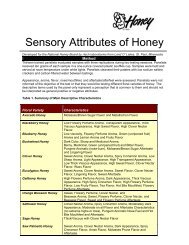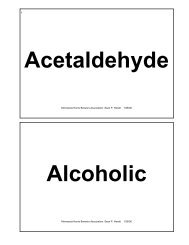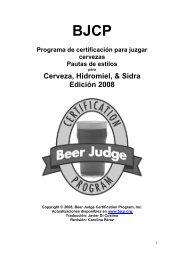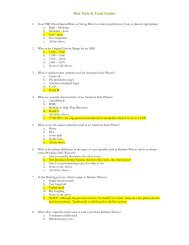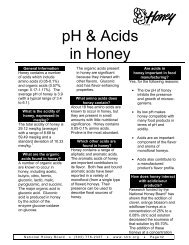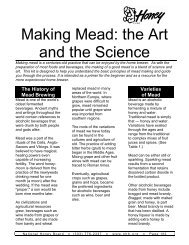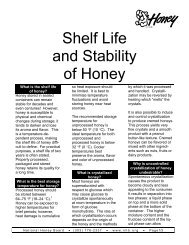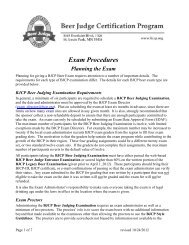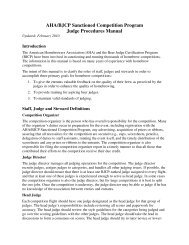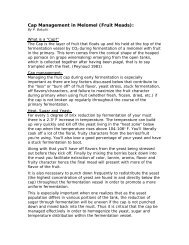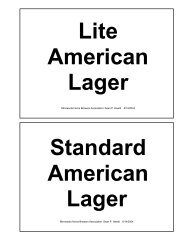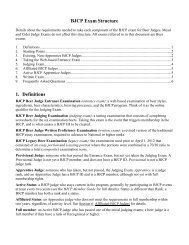Write comments about the degree to which the color, clarity, and head retention are appropriatefor the intended style and record a score. Score the beer for appearance, allocating a maximumof one point for each of these characteristics.6. Smell the beer again. Again, swirl the cup, bring it to your nose, and inhale the beer’s aromasseveral times. Note how the beer’s aroma changes as the beer warms and the volatiles begin todissipate. Write your impressions of the beers aromas, noting particularly the appropriateness ofthe malt, hops, yeast, and fermentation byproduct aromas. Also, note any lingering off aromas.Do not assign scores for aroma yet.7. Taste the beer. Take about 1 ounce of beer into your mouth, and coat the inside of your mouthwith it. Be sure to allow the beer to make contact with your lips, gums, teeth, palate, and thetop, bottom, and sides of your tongue. Swallow the beer, and exhale through your nose. Writedown your impressions of the initial flavors of the beer (malt, hops, alcohol, sweetness),intermediate flavors (additional hop/malt flavor, fruitiness, diacetyl, sourness), aftertaste (hopbitterness, oxidation, astringency), and conditioning (appropriateness of level for style). Do notassign scores for flavor yet.8. Score the beer for body (mouthfeel on the new). Take another mouthful of beer and note theappropriateness of the beer’s viscosity for the intended style. Write comments concerning yourimpression and assign between 2 and 5 points with higher numbers reflecting appropriatemouthfeel and lower numbers indicating increasing levels of lightness or heaviness for theintended style.9. Evaluate the beer for overall impression. Relax. Take a deep breath. Smell the beer again, andtaste it again. Pause to consider where the beer belongs in the overall range of scores (e.g.,excellent, very good, good, drinkable, problem) and where similar beers are ranked within thejudging flight. If you use a top-down decision making strategy, assign an overall score to thebeer, then mentally subtract points from the remaining subcategories (i.e., aroma and flavor),consistent with your impressions of how the beer is deficient. Use the overall impressioncategory to adjust your final score to the level you feel is appropriate for this beer. If you use abottom-up decision making strategy, assign scores to each of the remaining subcategories (i.e.,aroma and flavor), and assign a score for overall impression. Finally, write prescriptivesuggestions for improving the beer in light of any deficiencies you noted in your evaluation.Also, check any boxes on the left side of the scoresheet that are consistent with your comments.10. Check your scoresheet. Add your category scores. If you use a bottom up approach, doublecheck to make sure you added correctly. If you use a top down approach, make sure that yoursubcategory scores sum to equal your overall score. When the other judges have finished scoringthe beer, discuss the technical and stylistic merits of the beer and arrive at a consensus score. Beprepared to adjust your scores to make them fall within 5-7 points of the other judges at yourtable.Notes on Smelling the BeerWhen a beer judge smells a beer, the judge is literally inhaling small particles of the beer. The sense ofsmell works by detecting molecules that are diffused into the air. These molecules are inhaled into thesinus cavity where receptors (olfactory cells) detect and translate the chemical information contained inthe molecules into information that the brain can interpret. Several things influence a judge’s ability to13
detect the variety of aromas in beer. First, there are different densities of the receptors found in differentpeople. Hence, some judges may simply be more sensitive to odors than are other judges. Second, thereceptor cells can be damaged through exposure to strong substances (e.g., ammonia, nasal drugs), andthis damage may take several weeks to heal. Third, changes in the thickness of the mucus that lines thenasal cavity may influence a judge’s sensitivity. Any molecules that are detected by the olfactory cellsmust pass through a mucus lining, so daily changes in the thickness of that lining influences oursensitivity from day to day. The thickness of the lining can be influenced by sickness (e.g., colds), orexposure to a variety of allergens or irritants (e.g., pet dander, dust, smoke, perfume, spicy foods).Therefore, judges need to take into account their current levels of sensitivity, given their health andexposure to substances that could interfere with their sense of smell. Finally, the olfactory cells becomedesensitized to repeated exposure to the same odors. As a result, a beer judge may be less able to detectsubtle aromas as a judging session progresses. One way to remedy this problem is to occasionally takedeep inhales of fresh air to flush the nasal cavity. Another way to lessen desensitization to certain odorsis to sniff something that has a completely different odor (e.g., sniffing your sleeve) (Eby, 1993;Palamand, 1993).Regardless of a judge’s ability to detect various odors in beer, that ability is useless if the judge cannotuse accurately descriptive terms to communicate information to the brewer. Hence, it is important forbeer judges to build a vocabulary for describing the variety of odors (and knowledge of the source ofthose odors). Meilgaard (1993) presents a useful taxonomy of beer-related odors. His organizationalscheme categorizes 33 aromas into 9 overall categories (oxidized, sulfury, fatty, phenolic, caramelized,cereal, resinous, aromatic, and sour). Beer judges should make efforts to expand their scent recognitionand vocabulary.Notes on Tasting the BeerThe sense of taste is very similar to the sense of smell. Taste is the sense through which the chemicalconstituents of a solid are detected and information about them is transmitted to the brain. Themolecules are detected by five types of taste buds that are on the tongue and throat; some areas of thetongue are more sensitive to certain basic flavors than others, but the commonly-referenced TongueTaste Map has been debunked. For example, you can taste bitterness more towards the back of yourtongue, but the entire tongue can taste it. The five basic tastes detected by the tongue are sweetness,sourness, saltiness, bitterness and umami (savoriness).Since all of these flavors are present in beer, it is important that beer judges completely coat the insideof their mouths with beer when evaluating it and that the beer be swallowed. As is true for the scentreceptors in the nose, different people have different densities of taste buds and, thus, have differentsensitivities to various flavors. Also, taste buds can be damaged (e.g., being burnt by hot food orthrough exposure to irritants like spicy foods, smoking, or other chemicals), so a judge’s sensitivity maybe diminished until tastebuds can regenerate (about 10 days). Judges need to be aware of their ownsensitivities and take into account recent potential sources of damage when evaluating beers. Inaddition, taste buds can be desensitized to certain flavors because of residual traces of other substancesin the mouth. Therefore, it is best for judges to rinse their mouths between beers and to cleanse theirpalates with bread or salt-free crackers (Eby, 1993; Palamand, 1993).Of course, as is true for the sense of smell, a judge’s ability to taste substances in beer is useless unlessthat judge can accurately identify the substance and use appropriate vocabulary to communicate that14



